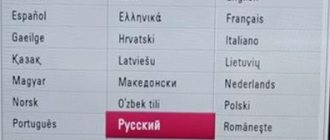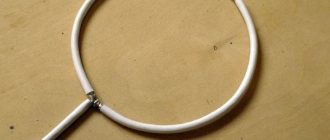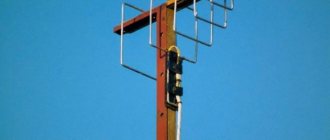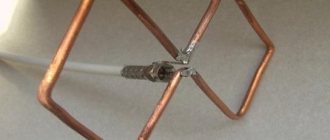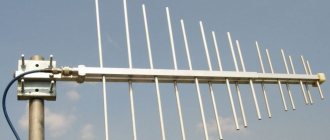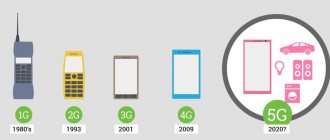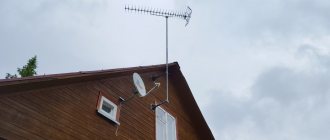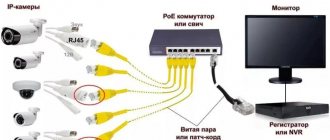Do you want to watch your favorite TV channels in high quality for free? Take advantage of the DVB T2 digital terrestrial television service. In many countries this standard has already become the main one over the past few years. Unfortunately, in Russia it is just beginning to gain popularity. Today, 20 of the most popular Russian channels are already available, and in the near future the organization responsible for technology development promises to add another package of channels.
If you need to regularly pay a monthly subscription fee for cable television, then the benefits of digital terrestrial television are obvious - having only paid once for a set of equipment, after about a year its cost is fully recouped and in the future you watch TV for free. In addition, it is very rare that you need the entire package of channels that is provided by cable or satellite providers. In today’s material we will tell you in detail what features the DVB T2 digital terrestrial television service has, as well as what you need to independently install and configure the equipment. Once you are armed with the knowledge, installing over-the-air antennas will be very simple and you can save significant money by not calling a professional. So let's get started.
Features of T2 digital television
Until recently, terrestrial television was associated with poor image quality, a large amount of various interference, and a minimal set of channels. It was necessary to manually tune each frequency separately, and different channels could operate in different bands, which led to the need to install several antennas or one multi-band one. In some cases, additional information could be received along with the signal, for example, teletext, when it was possible to receive information about a TV show or various entertainment content directly on the TV screen. Today, in the Internet era, such additional services have lost their relevance, but in the era of high-quality video and high-resolution screens, high-quality television pictures have become more in demand than ever. Therefore, a digital television standard was developed.
It is the use of digital technologies that has allowed us to reach a completely new level of quality. If earlier for this it was necessary to use exclusively satellite television, which entailed additional installation difficulties, and not everyone could afford the set of equipment, now it is enough to install and configure an almost ordinary decimeter antenna, in some cases an amplifier, as well as a television set-top box. And if you consider that many modern TVs already have a built-in DVB T2 receiver, then you can get by with just one inexpensive antenna.
Let's take a closer look at what advantages and disadvantages T2 digital terrestrial television has.
Advantages:
- Very high quality. If you have a modern plasma TV, you will initially be amazed at the incredibly clear picture.
- Absence of any interference. Forget forever what on-air noise and picture distortion look like.
- No subscription fee. All channels today can be watched absolutely free. In addition, there is no talk of introducing the board yet.
- Up to 20 of the most important Russian channels. Compared to the on-air three or four, this is just a fairy tale. We'll talk about the composition of channel packages a little below.
- Low cost of equipment. Forget about huge connection bills.
- Compatible with most modern TVs. Since many models support the DVB T2 format, you don't even have to buy a tuner.
- Possibility of high-quality reception with a regular antenna installed on the roof, or even with an indoor antenna in situations where you are close to the transmitting center. In this case, your investment will be minimal.
- Possibility of installation not only in a city apartment, but also somewhere outside the city. If you have a portable TV, you can even use DVB T2 digital television services while traveling. It can also be a great help if you live in an area that doesn't have cable coverage.
- A very simple setup process that almost anyone can handle without any difficulties or special knowledge.
Despite the huge number of advantages, there are a number of certain disadvantages:
- DVB T2 digital terrestrial television coverage is not available everywhere. There are several channel packages, so in some places there may be not 20 available, but 10. We will also talk about this a little below.
Digital receiver DBV-T2
- If the antenna is not aimed at the transmitter correctly, friezes may appear - that is, when the picture freezes and looks like a square. In some cases this may be due to bad weather conditions.
- Higher sensitivity to weather, terrain, atmospheric conditions compared to an analog signal. Analogue television, although of lower quality, is more stable. Older people can probably share an example when a signal could be received on a metal hanger or a tin can. This won't work with digital.
- Compared to cable or satellite television, there are quite a few channels, depending on the area there are 10 or 20. They promise another package, but the release date is still unknown.
- To enjoy the full benefits of digital signal quality, you will likely need to purchase additional advanced equipment.
- Not every channel broadcasts in high HD quality. If this is not noticeable on a regular telescope TV, then on modern LCD and plasma panels the grain can hurt the eye.
- Differences in the broadcast format of different channels. Some broadcast in modern 16:9, while others broadcast in outdated 4:3. Depending on your TV model, you will see dark bands either vertically or horizontally. If the TV settings are incorrect, the picture will be compressed or stretched.
Can I use a regular one?
In general, you can receive a digital signal with any antenna . Even the one you have installed now will be able to receive a digital signal. A decimeter or “Polish” antenna will also receive the signal. Of course, it all depends on the place where you are, the terrain, etc. While in the city, you don’t have to use the antenna at all, everything will be picked up just the same. Of course, it is better to take at least a piece of wire or buy an antenna without an amplifier.
If the tower is not close, then you can either buy an antenna with an amplifier, or buy a decimeter antenna for digital TV. But if there is no signal, then you need to raise the antenna and install it on the pipe. It is also important that the antenna is correctly configured and installed in the direction of the tower. You can find out below how to place it correctly and in which direction to point it in your country.
The state of digital television in Russia
In some ways, Russia has lagged behind other European countries. Their DVB T2 television format has long ago become a generally accepted standard, and in many places there is no analogue broadcasting at all. In Russia today there is a transitional stage, when everyone realizes the need to abandon analogue television, but the digital infrastructure is not yet sufficiently developed. In general, in most large cities you will be able to catch a number without any problems, but if you live in very remote regions, you will either have to be content with one multiplex, or just be patient. Fortunately, there are practically no such places left; the signal covers, by and large, all populated areas.
Now let's talk about the content of channel packages or, as they are officially called, multiplexes. Today there are 2 multiplexes broadcasting with 10 channels each. In the coverage area of DVB T2 digital terrestrial television, reception of the first multiplex is guaranteed, while the 2nd is not yet available everywhere. There is talk about launching a third package, but due to the shortage of frequency resources and the need to free up frequencies for it by turning off analogue broadcasting, the launch date is still unknown.
What channels are included in each package? At the beginning of May 2017, their composition was as follows:
| Multiplex-1 | Multiplex-2 |
| First | Ren TV |
| Russia 1 | Saved |
| Match TV | STS |
| NTV | Home |
| Channel 5 | TV-3 |
| Culture | Friday! |
| Russia 24 | Star |
| Carousel | World |
| OTR | TNT |
| TVC | Muz TV |
Please note that the content of multiplexes is not constant and changes from time to time. This has happened several times over the past few years. In any case, the set is quite diverse and there are channels for every taste and for every audience.
How to reconfigure your TV to receive over-the-air television?
- Technical group. Setting the desired frequency, processing speed, etc.
- Search engine . The process of searching for channels on a TV.
- Personal customization . This setting involves selecting the interface language, setting a password (if necessary), enabling channel sorting, etc.
Now let's go through each of these groups:
- Technical settings group. Their difficulty is in choosing the right frequency at which the search will take place. But on some TV models this will be easier to do. There, when you select a receiver (cable, antenna or satellite), the frequency is selected automatically. The rest have only manual adjustment. This was written in more detail above.
- Search engine . In this group, the TV searches for channels in automatic or manual mode.
- Personal customization. Everything here is to your taste; if you want, you can set a password, adjust the order of channels or change the language.
On older models
Some grandparents have televisions that are the same age as our grandparents. And in those days they didn’t even know what an HDMI port was. How to connect an antenna to a TV is written above. For settings:
- You need to press the AV button and search for channels.
- Then they need to be preserved and rejoiced.
On modern
On newer TVs that already have an HDMI port, it is better to use it. This way the potential of the set-top box (or built-in tuner) will be fully revealed, that is, the picture quality will be high.
- On the TV you need to select the “HDMI” operating mode.
- Enter a password that may be needed for, for example, parental controls. If you have not set a password, you will either not be asked for one, or enter 0000.
- Choose your region.
- Then tabs will open asking you to save a set of channels.
That's all, now you can watch channels in good quality.
In conclusion, I would like to say that setting up the TV, choosing an antenna, its directions, etc. – this is not difficult to do if you have such instructions. Everything should work out for you!
Necessary equipment
So, what equipment do you need to purchase to watch DVB T2 digital terrestrial television? Depending on the equipment you already have and the distance from the transmitting center, you may need the following set:
- UHF antenna. It will be needed in any case, since without it the signal will not be received. Antennas can be either indoor or outdoor. If you live in the center of a large city, not far from the transmitter, a regular indoor antenna will be sufficient. If you live outside the city or in a remote area, you will need an outdoor antenna installed on the roof at the maximum accessible height. If you do not know where the nearest transmitting station is located, please look at the map available at this link (https://map.rtrs.rf).
Digital terrestrial television distribution map
If there is a high-quality signal, there is no point in using an amplifier, since it will amplify not only the direct signal, but also the one reflected from various obstacles. In conditions of multi-storey urban development, this will only lead to worse results. Use an amplifier only when you live in a village and the transmitter is located quite far away.
- TV. Everything is logical here, no TV - no viewing. Please note that most modern models have a built-in DVB T2 signal receiver. Be careful, as a number of previous generation models support DVB T, and this standard is incompatible with the current one in Russia.
- TV set-top box-tuner. If your TV does not have a built-in module, to display the radio signal on the TV you will need to connect a special tuner that can work in the DVB T2 standard. The full list of stores can be found on the project’s official website on this page.
Which cable to choose and how to lay it
The quality of digital TV broadcasting depends not only on the correct installation of the antenna, but also on the cable used.
The modern market offers dozens of wire models; it is not surprising that users have a lot of questions about choosing the best option. Answers to the most frequently asked questions can be found below.
Vyacheslav
For several years he worked in mobile phone stores of two large operators. I understand tariffs well and see all the pitfalls. I love gadgets, especially Android ones.
Ask a Question
Question to the expert
Does the signal level depend on the conductor cross-section?
Yes, directly. The larger the cross section, the better the impulse is transmitted over long distances. If the receiver is located 30 m away from the repeater, this figure should be 1 mm².
What material is the conductor made of?
Made of copper and copper-plated steel.
Does the amount of attenuation affect signal quality?
Yes, in inverse proportion. The smaller the value, the higher the quality.
What characteristic impedance should a cable for digital TV have?
It should be 75 ohms. Sometimes sellers offer RG-58A or RG-58C models, but they are not suitable for digital broadcasting
What brands of coaxial cable for digital television are popular?
Today there are several models that meet the requirements of digital broadcasting. These are: RG-6U; RK-75; SAT-50; SAT-703; DG-113.
Antenna installation
It is almost impossible to list all special cases and conditions of admission in one article. Therefore, we will give only general recommendations that should be taken into account when installing a DVB T2 digital television antenna.
Room
Place the antenna on the windowsill and turn it towards the transmitting tower. Make sure there are no radio sources nearby, such as a Wi-Fi router. The distance between them should be at least several meters.
Indoor antenna D-Color Dca-115
Outdoor
External antennas also need to be turned towards the tower and securely secured so that wind or other weather conditions cannot disturb its position. It is best to first install a reliable bracket and attach it to the wall or roof of the house, and then attach the antenna to it. This will allow you to vary the position of the device. When installing, be sure to keep in mind that you will have to rotate it to fine-tune it, so do not fasten it right away, it is better to do this after completing the full installation.
General Tips
- Don't rush to use the amplifier. Try experimenting without it first. Twist the antenna or move it a little to the side, sometimes this can help significantly. If all else fails, only then use the amplifier.
- If you plan to use several TVs, the antenna must be external. By the way, in this article you can learn how to connect several TVs to one antenna.
- Minimize situations where the signal is shielded or blocked. For example, do not place the antenna under a metal roof or near a multi-story building that is blocked by a tower or high-voltage lines. True, in some cases it is possible to use the signal reflected from a high structure and amplify it using an amplifier.
- Remember that with the transition from analogue to digital broadcasting, only the type of signal transmitted has changed. The antenna is still used directional and must be strictly oriented towards the transmitting station. Deviating it to the side even by a few degrees can significantly degrade the quality of reception, even to the point of disappearing completely. The further away the station is, the more accurately the antenna needs to be aimed and the higher it should be. Although, if the terrain is fairly flat, the signal can be caught with an indoor antenna at a distance of up to 20 km from the transmitter, its position also needs to be very precisely selected.
Installation in a private house
You have an antenna, you know in which direction it needs to be turned, and the most important thing left is to install it correctly.
- In private homes, antennas are mounted higher using a mast. The masts themselves, also known as “rods,” can be prefabricated metal or telescopic iron. The most practical way to install a mast is to secure it between two outrigger brackets. Those, in turn, are conveniently mounted on a brick pipe or on the wall on the side of the house.
- Now you need to secure the cable. It is fixed on the mast with an isolette or clamps every 30-60 cm. The cable is led into the room through a specially drilled hole in the roof. If necessary, it is first connected to the amplifier, powering the cable wiring on it, and then to the TV. In order to avoid damage to the cable or TV signal, you must avoid breaking it and not pinching it during the fastening process.
If the antenna is located at the highest point of the house, grounding it is contraindicated. Otherwise, it will more often take on lightning strikes.
But if the antenna is not that high, it is still advisable to put an insulator in the cable section between the antenna and the amplifier.
Fine-tuning signal quality
You can, of course, accurately capture a signal of the proper strength and quality yourself, without the use of additional equipment. However, in difficult reception conditions, it is best to use a special device for tuning over-the-air antennas. What is such a device? Usually this is a small box with a mechanical dial or liquid crystal screen that displays the signal strength. On one side the power is connected, and on the other there is an input for connecting the antenna cable. Since adjusting the antenna based on the visual perception of the image on the screen is not the most reliable, such a device will greatly simplify your task.
- Take the device and connect the antenna cable to it, and also supply power either from the built-in batteries or from an external battery pack.
- Turn the antenna towards the receiver. If the direction is correct, the device will immediately begin to emit a sound signal, and the numbers or arrow will appear on the scale.
- If the device shows insufficient signal level, change the position of the antenna by turning it to the side, raising it higher or lowering it lower. Achieve maximum signal performance.
- Turn off the device, secure the antenna and you can start setting up the equipment.
Connecting the antenna to the TV
Connecting an HDMI cable to a digital TV tuner
If you have a built-in DVB T2 receiver
- Find a special input on your TV for connecting an external antenna. It is usually signed Ant In.
- Connect the cable coming from the antenna to this connector. During this time, the TV must be turned off for safety reasons.
- Turn on the TV and activate the digital tuner in the settings.
- Perform automatic channel search.
- Enjoy watching.
When using a digital tuner set-top box
- Connect the cable coming from your antenna or amplifier to the antenna input on your set-top box.
- Connect the set-top box to the TV. Ideally, this should be an HDMI cable, as it provides the highest quality video signal. If this interface is not available, connect the two devices using traditional analog connectors, the so-called tulips. There should be 3 of them, they are indicated in different colors. Usually it is yellow, red and white. Two of them are audio connectors, while the third is video. Most often, the connectors on both the TV and the set-top box have the same color designation, so it is quite difficult to confuse them.
- Turn on the TV and use the remote control to select the external signal source to which the tuner is connected. This can be either HDMI or AV. It all depends on the connection method.
- Search your set-top box automatically for TV channels or configure each one manually. There is no need to configure anything on the TV.
Digital tuner box
Where to point the antenna to receive digital TV
When using an indoor TV antenna, it is important to install it correctly. There are several recommendations:
- It should be oriented towards the TV tower. The more accurately the direction is, the less noise.
- There should be no serious obstacle between the receiver and the repeater. An example is the walls of a house. Glass transmits signals best. Therefore, they often decide to install the receiver in windowed mode.
- To improve broadcast quality, you need to place the antenna much higher. If the structure is small, it is suspended at the top of the window opening. In this case, the design of the window frame is taken into account: metal elements become a source of noise.
The signal level is determined on a digital set-top box or TV. Modern models display the active connection and reception level.
Connecting more than one TV
So, as announced earlier, it’s time to touch on the issue of when there is more than one connected TV.
This question, and it is quite complex, should be divided into two variations:
- There are two TVs, one has a built-in DVB-T2 receiver, the second is connected via a corresponding set-top box;
- There are two TVs, neither of them has built-in support for analog TV and both connect to the same set-top box.
If everything is simple in the first question, to implement your plan you only need to purchase an antenna splitter, which can be bought at any radio store or radio market.
The connection diagram will take the following form: Antenna - splitter - cable to one TV to the corresponding connector on the TV - cable to the second TV - to the corresponding connector on the set-top box.
Each TV will be controlled independently of the other.
The second question is difficult because after connecting, the image will be the same for both TVs, and this cannot be changed without purchasing an additional set-top box.
The connection diagram is simple (approximately) – Antenna – cable to the TV set-top box – HDMI to one TV – RCA to another TV – Common picture for two TVs.
Therefore, if you need to connect several TVs to digital television, you should decide whether you want to save money or want to be able to watch TV comfortably.

